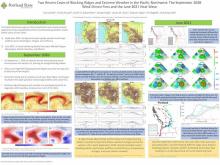Two Recent Cases of Blocking Ridges and Extreme Weather in the Pacific Northwest: The September 2020 Wind-Driven Fires and the June 2021 Heat Wave
Paul
Loikith
Portland State University, Department of Geography
Poster
The Pacific Northwest region of the United States and Canada recently experienced two exceptionally extreme and devastating weather events within a year of each other. In September of 2020, a wind storm of unprecedented strength for the time of year drove the most devastating wildfire event in recent history across the states of Oregon and Washington. These wind-driven fires rapidly burned large swaths of forest and devastated several communities. Then, in June of 2021, a heat wave of historical proportions affected much of the Pacific Northwest, with multiple all-time high temperature records broken by several degrees. While the impacts of the two events were different in many ways, both were related to a highly anomalous blocking ridge. In each case, records for high geopotential height were broken within the ridge, however in the September 2020 event, daily record low geopotential heights were also recorded adjacent to the ridge, evidence of the extreme amplitude of the tropospheric wave comprising the block. This presentation documents and explores how these two blocking events contributed to such extreme surface weather across the region. Synoptic analysis is used to understand the evolution of the upper-level ridges, from formation to demise, and how other key meteorological variables were influenced by the blocking pattern. Air parcel backwards trajectories are further utilized to diagnose the origin of the surface anomalies in temperature, moisture, and wind, that drove the impacts on humans and the environment. Results of climate model projections of future ridge frequency and strength are presented, and generally do not suggest that the frequency and/or strength of warm season ridging similar to these events is likely to increase over this region.

Presentation file
Loikith_Paul_Blocking-poster.pdf
(1.15 MB)
Meeting homepage
